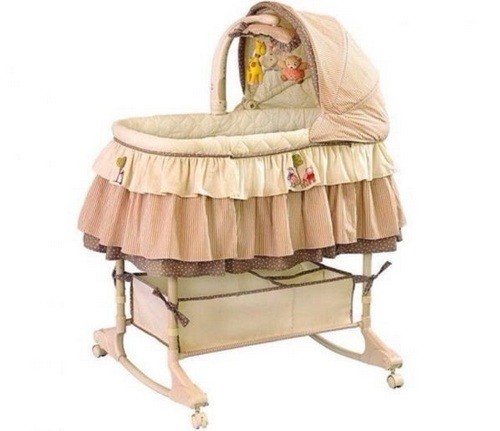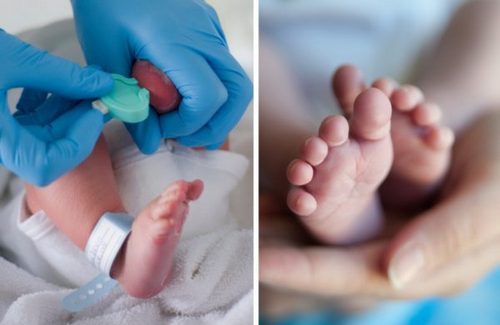Today, more and more mothers refuse disposable diapers in favor of reusable ones. These products are fabric panties with a special absorbent liner. Reusable diapers are of high quality and meet the main requirements: they do not cause irritation and allergies, they pass air well and retain moisture.
Diapers are made of silk, wool, cotton, fleece. The absorbent layer is made of bamboo or microfiber, and the outer one is made of polyester, as well as microfleece and micro suede with a membrane waterproof film.
Consider how to make a reusable diaper and what types they are.
Types of Reusable Diapers
Manufacturers offer a variety of models.
Diapers with a pocket
Panties have a special compartment under the liner. The pocket is made of thin material. It passes moisture, but does not absorb it.
All fluid remains in the liner. This layer must be changed and washed after each urination. The diaper will dry quickly, and the liner will take a long time, so it’s better to have a few in stock.
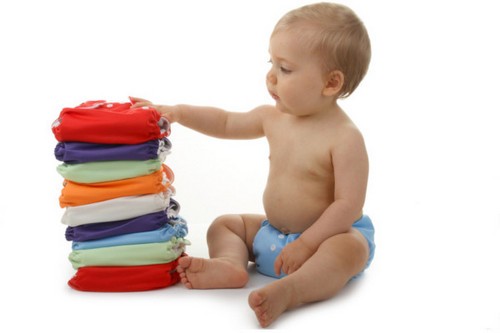
All in one
For such reusable panty diapers, the absorbent and waterproof layers are sewn together. They are worn on the baby on the principle of a disposable product. Velcro or buttons are used for fixing.
The diaper should be changed after each departure of a natural need. Due to the crosslinked layers, they dry for a long time.
Integrated diaper
It completely lacks a waterproof layer, so for use it is necessary to acquire special protective pants. This type of product is able to absorb a lot of liquid in a short period of time.
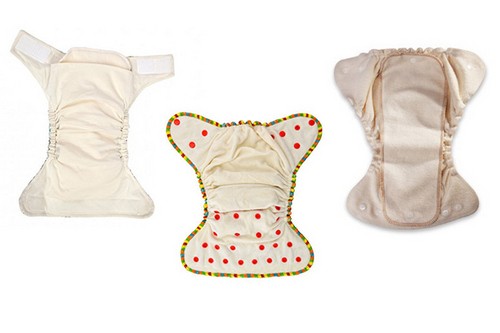
Diaper Contour
The product resembles a built-in diaper, only there is no absorbent layer in it. Such a diaper is fastened with a special pin or Snappi fastener. For panties, a protective cover is needed.
Prefold
This diaper has a rectangular shape, Inside it is divided into 3 parts. The middle is thicker than the edges due to more layers.
Prefold can be used as a liner or an independent diaper complete with protective panties. For fastening you will need a Snappi fastener.
Flat diaper
It is a single layer fabric square. For fastening you need a Snappi fastener or a special pin. Protective pants are required to prevent leakage. This diaper can be used as a diaper. It dries quickly.

Training panties
They are needed when the child begins to walk on the potty. The diaper is with a special layer and without it. Panties are used as a safety net in case the baby does not have time to reach the pot.
Hybrids
This product consists of two parts: a protective case and an insert. The absorbent layer can be made of fabric or disposable.
Diapers for bathing
The product is intended for classes in the pool and beach holidays. Top nylon coating reliably retains moisture inside. The elastic bands fit snugly against the legs and waist, preventing leakage.

Comparison of reusable and disposable diapers
In order to find out which diapers are better, disposable or reusable, you need to evaluate the pros and cons of each.
Reusable nappies
Pros:
- Suitable for children weighing from 3 to 15-18 kg. The size of the reusable diaper is fixed using Velcro or buttons.
- Allows you to control the amount of urination for a certain period of time.
- It’s enough to wash the panties and they are ready to use again.
- Despite the price, reusable diapers are more economical, as they are bought for a long time. Some mothers prefer to make reusable diapers with their own hands.
- Made from environmentally friendly and natural materials. The child’s skin “breathes” in them, does not need a cream or powder, and the risk of allergic reactions and diaper rash decreases to zero.
- In a reusable diaper, the child feels wet well. He quickly learns to control urination and early enough begins to ask for a pot.
- No environmental damage. The recycling process is fast and natural.
Minuses:
- Need to change more often than a disposable diaper.
- The amount of washing increases significantly.
- Requires some skill in putting on the first time. If used improperly, diapers leak, the inner layer crumbles, and the baby is uncomfortable.
- Volumetric. Pants should be wide enough, otherwise they can’t be put on a diaper.
- In babies up to 3 weeks, panties can leak, as they are often great. The diapers on the ties will help to solve the problem.
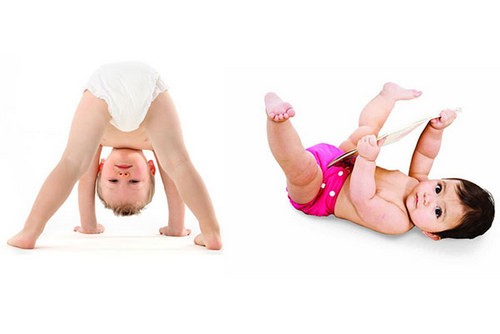
Disposable diapers
Pros:
- Changing the diaper takes little time.
- It is not required to wash a lot and plant a child on a pot at night.
- Size is smaller than reusable. It is almost invisible under clothes.
Minuses:
- Only suitable for a certain age. As the child grows up, the following size should be acquired.
- There is no way to control urination.
- It can not be used several times. The dirty diaper is discarded and replaced with a new one.
- Disposable diapers spend more money than reusable ones. Until the moment the child begins to walk on the potty, a significant part of the family budget will be spent on diapers.
- For the manufacture of synthetic materials, a polymer absorbent, flavorings and perfumes are used. The skin in them often fades, redness and irritation appear, an allergic reaction may occur.
- In a disposable diaper, the baby is always dry. Because of this, the process of accustoming to the pot is postponed for a significant period.
- For the manufacture of disposable diapers for one baby, it is necessary to cut down 4-5 trees. The timing of the decomposition of the used material is not exactly known, but some experts call the figure 250-500 years.
- It is not recommended to use: for a child up to 1 month old, for premature babies, with diarrhea, fever and fever, dermatitis, diathesis, eczema, if redness appears when using disposable diapers of any brand.
Which reusable diapers are better?
A large number of manufacturers of panties are represented on the market. Among them, there are several of the most popular. So which reusable diapers are better?
Gloryes
For manufacture, the manufacturer uses microfiber, charcoal bamboo, cotton, hemp fiber. The product is suitable for children weighing 3-15 kg and 3-18 kg. GlorYes presents reusable diapers with Velcro or buttons to adjust the size. The manufacturer presents models with a removable or sewn-in liner and panties for training in the potty.

Pluses of reusable GlorYes diapers:
- easy to take off and put on;
- long service life with proper care;
- to increase the absorbency of the diaper, you can use several liners;
- baby’s skin is always clean, without diaper rash and allergic reaction
- prevention of hip dysplasia;
- attractive appearance.
Minuses:
- made of artificial materials;
- liners and models with an absorbent layer dry for a long time;
- should be washed immediately after use, otherwise spots and an unpleasant odor may remain;
- withstand 2-3 urination in children up to six months, older children require replacement after each administration;
- panties with several inserts significantly increase in volume;
- models with buttons are difficult to adjust: if you fasten it weakly, leakage is possible, if it is tight, there are footprints on the legs.
Coolababy
Diapers are designed for children weighing 3-15 kg and 3-18 kg. Reusable diaper panties are made of charcoal or bamboo fiber, microfleece. The outer layer is made of polyester with a polyurethane coating. The size is adjusted using buttons and Velcro. There are models with a removable and sewn-in liner or without it.
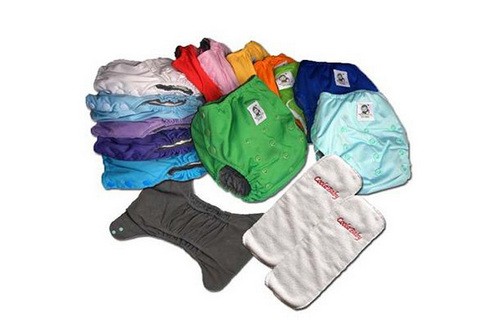
Pluses of reusable Coolababy diapers:
- long service life with proper care;
- easy to take off and put on;
- to increase the absorbency of the diaper, you can use several liners;
- prevention of hip dysplasia;
- the baby’s skin is always clean, without diaper rash and an allergic reaction;
- attractive appearance.
Minuses:
- made of artificial materials;
- withstand 2-3 urination in children up to six months. Older children require replacement after each administration;
- panties with several inserts significantly increase in volume;
- must be washed immediately after use so that no stains and unpleasant odors remain;
- liners and models with an absorbent layer dry for a long time.
“Silent”
Natural cotton is used as the main material for Nepromokashka reusable diapers. The absorbent liner is made of microfiber and the surface is of a microporous membrane. The size of the diapers is adjusted using Velcro or buttons. Panties are designed for children weighing 3-9 kg, 9-14 kg, 11-13 kg, 14-16 kg. The manufacturer offers diapers with a removable or sewn-in liner, panties for training in the potty and for bathing.
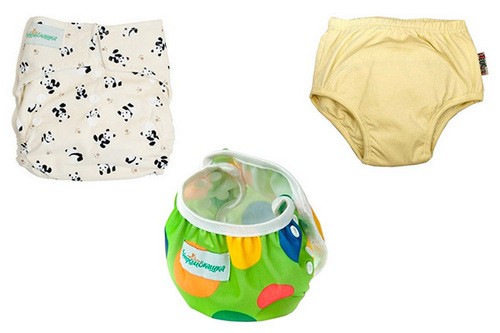
Pros:
- wear-resistant with proper care;
- It is convenient to take off and put on;
- to increase the absorbency of the diaper, you can use several liners;
- prevention of hip dysplasia;
- do not cause diaper rash and allergies;
- made of natural materials;
- attractive appearance.
Minuses:
- liners and models with an absorbent layer dry for a long time;
- not suitable for long walks and night sleep, as you need to often change clothes;
- can flow in the area of the legs or through the outer layer;
- if there are several inserts in the panties, then the diaper becomes very voluminous;
- the liner is longer than the pocket;
- there are products that are smaller than the size indicated on the package.
Do-it-yourself reusable diaper
How to sew a reusable diaper with your own hands? For work, you need patterns (they can be found on the Internet) and a flannel. To keep the priest dry, make the inner layer of fleece. If you want your pants to get slightly wet, use this fabric for the outer layer.
Progress:
- Cut the diaper parts from the desired material. Old T-shirts, towels, T-shirts, sheets, fleece shreds, etc. are suitable for an insert into reusable diapers. The interlayer can be made in the form of a rectangle or use the insert pattern.
- Put the absorbent layer on the wrong side of the inside of the diaper and baste. Then fold the outer and inner layers of the diaper facing inward. Sew along the contour, leaving a small section unstitched. Turn to the front side.
- On the back of the diaper, draw a drawstring, sew. Insert the gum into the resulting pocket and stitch it at the ends. In order for the diaper to fit the legs well, also draw a drawstring in this place and insert the elastic band or simply sew it to the side allowances.
- Turn the panties to the front side, fold the unfinished edge inward and sew. Then sew the entire product along the contour. Finally, attach Velcro or buttons.
Be sure to iron the diaper after each stitching. Make Velcro lapels to cover during washing.
How to use and wash?
How to use reusable diapers? Often, mothers are faced with the problem of diaper leakage. The fact is that the new fabric absorbs worse than the one that was in use. Manufacturers warn about this and guarantee a solution to the problem after several washings.
Products are washed manually or in a machine on a delicate mode. It is better to do this in the evening, so that in the morning there are clean and dry panties. Before washing, read the instructions for care of the products.
What can not be done with diapers:
- machine washable at more than 30-40 degrees;
- use rinsing agents, conditioners, soap, chlorine bleach;
- pour a lot of powder;
- iron;
- dry on a battery.
How many reusable diapers are needed?
Before buying, parents ask themselves: how many reusable diapers are needed for a child? For a day, the baby will need 10-11 panties. For sleep – 4 units with a thick liner (3 – at night, 1 – in the afternoon), for wakefulness, including walking – 5-6 units with a thin liner (2 – in the morning, 3-4 – in the afternoon). To be calm, and not to think about what to dress the child in, stock up on 15-20 panties.
The benefits of purchasing reusable diapers are obvious: clean healthy baby skin and significant cost savings. Do not forget about the environment. It depends only on us how pure a planet we leave for future generations.

